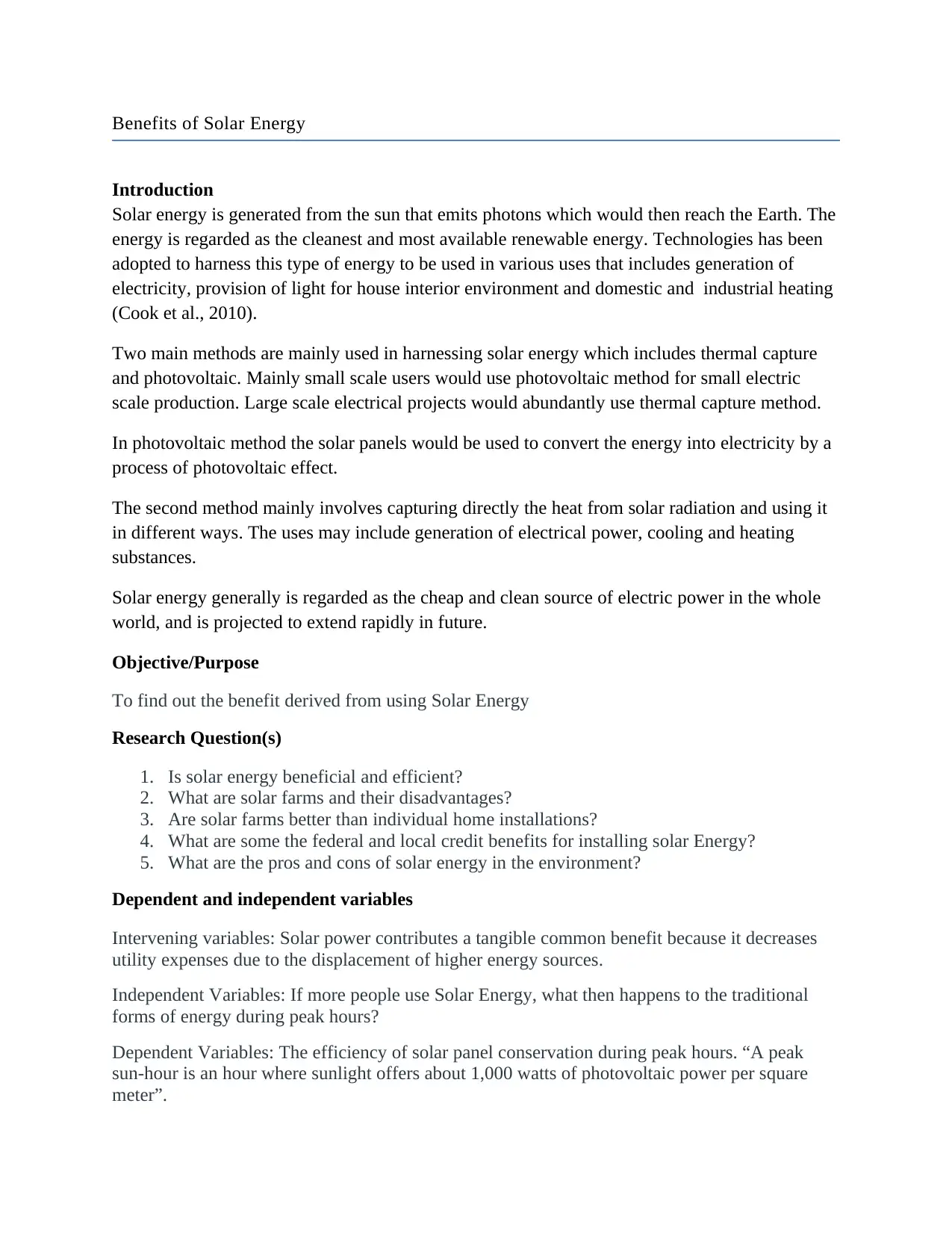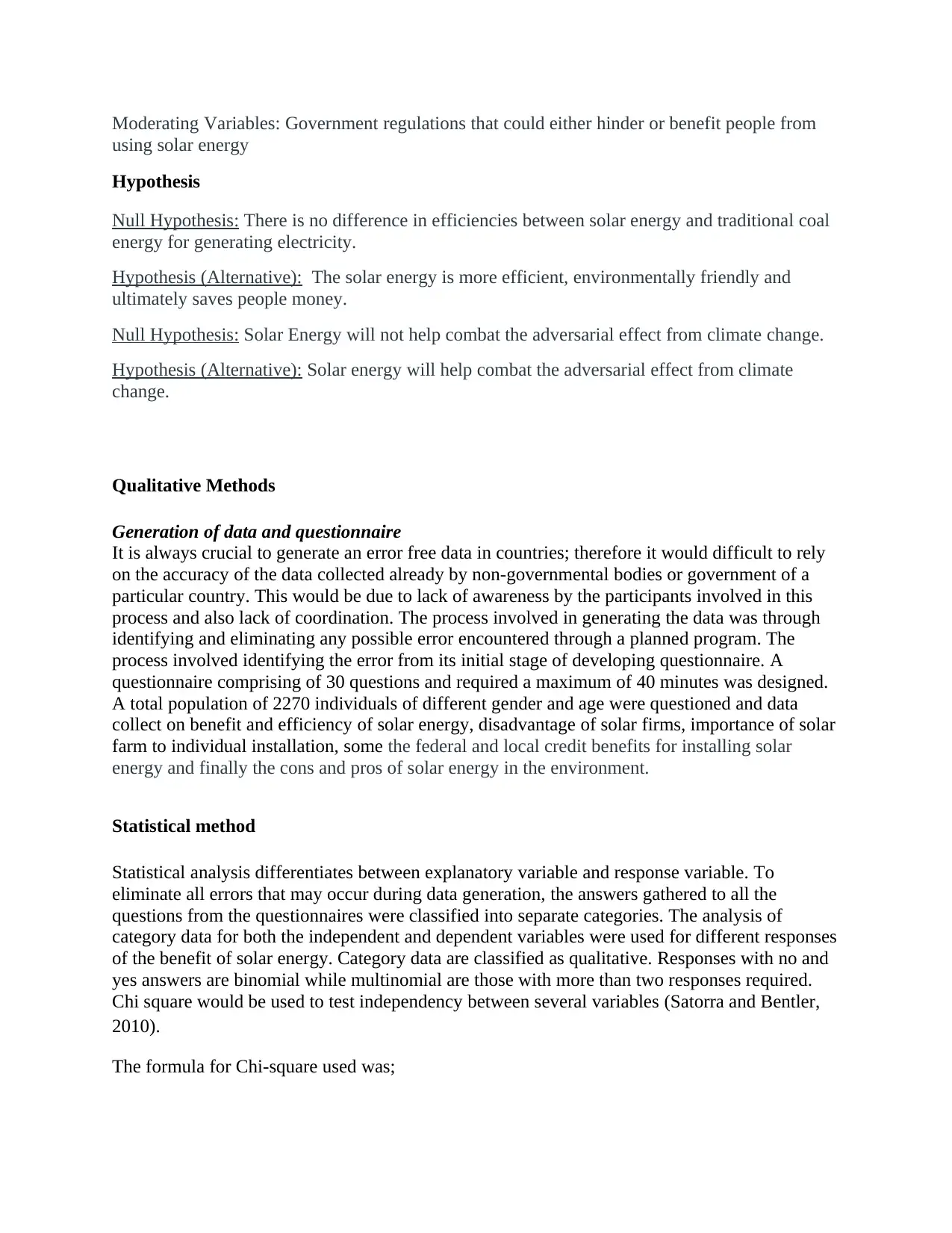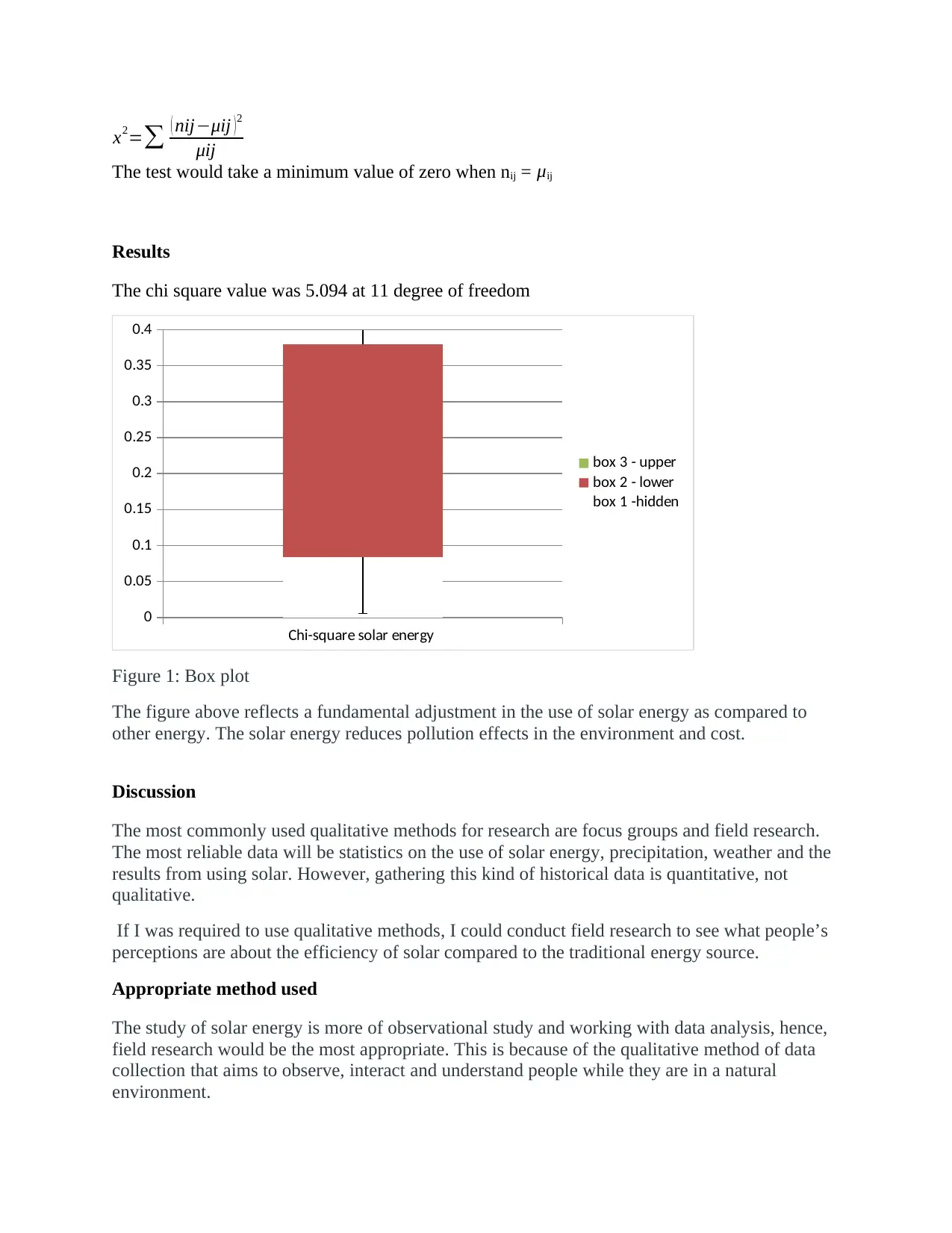Comprehensive Report: Analyzing the Benefits of Solar Energy
VerifiedAdded on 2022/12/27
|4
|1141
|67
Report
AI Summary
This report delves into the benefits of solar energy, addressing research questions related to its efficiency, the advantages and disadvantages of solar farms, and the environmental impact. It identifies independent, dependent, and intervening variables, formulating null and alternative hypotheses to examine the efficiency and environmental benefits of solar energy compared to traditional sources. The report details a qualitative method involving a questionnaire distributed to 2270 individuals, followed by statistical analysis using the Chi-square test to assess the relationship between various factors and the adoption of solar energy. Field research is proposed as an appropriate method for gathering qualitative data on public perceptions of solar energy's efficiency. The discussion highlights the advantages of field research in uncovering detailed insights into people's experiences and the role of social context, while also acknowledging its limitations in gathering data from large populations. The report concludes by referencing relevant studies on solar energy supply, storage, and statistical testing methods.

Benefits of Solar Energy
Introduction
Solar energy is generated from the sun that emits photons which would then reach the Earth. The
energy is regarded as the cleanest and most available renewable energy. Technologies has been
adopted to harness this type of energy to be used in various uses that includes generation of
electricity, provision of light for house interior environment and domestic and industrial heating
(Cook et al., 2010).
Two main methods are mainly used in harnessing solar energy which includes thermal capture
and photovoltaic. Mainly small scale users would use photovoltaic method for small electric
scale production. Large scale electrical projects would abundantly use thermal capture method.
In photovoltaic method the solar panels would be used to convert the energy into electricity by a
process of photovoltaic effect.
The second method mainly involves capturing directly the heat from solar radiation and using it
in different ways. The uses may include generation of electrical power, cooling and heating
substances.
Solar energy generally is regarded as the cheap and clean source of electric power in the whole
world, and is projected to extend rapidly in future.
Objective/Purpose
To find out the benefit derived from using Solar Energy
Research Question(s)
1. Is solar energy beneficial and efficient?
2. What are solar farms and their disadvantages?
3. Are solar farms better than individual home installations?
4. What are some the federal and local credit benefits for installing solar Energy?
5. What are the pros and cons of solar energy in the environment?
Dependent and independent variables
Intervening variables: Solar power contributes a tangible common benefit because it decreases
utility expenses due to the displacement of higher energy sources.
Independent Variables: If more people use Solar Energy, what then happens to the traditional
forms of energy during peak hours?
Dependent Variables: The efficiency of solar panel conservation during peak hours. “A peak
sun-hour is an hour where sunlight offers about 1,000 watts of photovoltaic power per square
meter”.
Introduction
Solar energy is generated from the sun that emits photons which would then reach the Earth. The
energy is regarded as the cleanest and most available renewable energy. Technologies has been
adopted to harness this type of energy to be used in various uses that includes generation of
electricity, provision of light for house interior environment and domestic and industrial heating
(Cook et al., 2010).
Two main methods are mainly used in harnessing solar energy which includes thermal capture
and photovoltaic. Mainly small scale users would use photovoltaic method for small electric
scale production. Large scale electrical projects would abundantly use thermal capture method.
In photovoltaic method the solar panels would be used to convert the energy into electricity by a
process of photovoltaic effect.
The second method mainly involves capturing directly the heat from solar radiation and using it
in different ways. The uses may include generation of electrical power, cooling and heating
substances.
Solar energy generally is regarded as the cheap and clean source of electric power in the whole
world, and is projected to extend rapidly in future.
Objective/Purpose
To find out the benefit derived from using Solar Energy
Research Question(s)
1. Is solar energy beneficial and efficient?
2. What are solar farms and their disadvantages?
3. Are solar farms better than individual home installations?
4. What are some the federal and local credit benefits for installing solar Energy?
5. What are the pros and cons of solar energy in the environment?
Dependent and independent variables
Intervening variables: Solar power contributes a tangible common benefit because it decreases
utility expenses due to the displacement of higher energy sources.
Independent Variables: If more people use Solar Energy, what then happens to the traditional
forms of energy during peak hours?
Dependent Variables: The efficiency of solar panel conservation during peak hours. “A peak
sun-hour is an hour where sunlight offers about 1,000 watts of photovoltaic power per square
meter”.
Paraphrase This Document
Need a fresh take? Get an instant paraphrase of this document with our AI Paraphraser

Moderating Variables: Government regulations that could either hinder or benefit people from
using solar energy
Hypothesis
Null Hypothesis: There is no difference in efficiencies between solar energy and traditional coal
energy for generating electricity.
Hypothesis (Alternative): The solar energy is more efficient, environmentally friendly and
ultimately saves people money.
Null Hypothesis: Solar Energy will not help combat the adversarial effect from climate change.
Hypothesis (Alternative): Solar energy will help combat the adversarial effect from climate
change.
Qualitative Methods
Generation of data and questionnaire
It is always crucial to generate an error free data in countries; therefore it would difficult to rely
on the accuracy of the data collected already by non-governmental bodies or government of a
particular country. This would be due to lack of awareness by the participants involved in this
process and also lack of coordination. The process involved in generating the data was through
identifying and eliminating any possible error encountered through a planned program. The
process involved identifying the error from its initial stage of developing questionnaire. A
questionnaire comprising of 30 questions and required a maximum of 40 minutes was designed.
A total population of 2270 individuals of different gender and age were questioned and data
collect on benefit and efficiency of solar energy, disadvantage of solar firms, importance of solar
farm to individual installation, some the federal and local credit benefits for installing solar
energy and finally the cons and pros of solar energy in the environment.
Statistical method
Statistical analysis differentiates between explanatory variable and response variable. To
eliminate all errors that may occur during data generation, the answers gathered to all the
questions from the questionnaires were classified into separate categories. The analysis of
category data for both the independent and dependent variables were used for different responses
of the benefit of solar energy. Category data are classified as qualitative. Responses with no and
yes answers are binomial while multinomial are those with more than two responses required.
Chi square would be used to test independency between several variables (Satorra and Bentler,
2010).
The formula for Chi-square used was;
using solar energy
Hypothesis
Null Hypothesis: There is no difference in efficiencies between solar energy and traditional coal
energy for generating electricity.
Hypothesis (Alternative): The solar energy is more efficient, environmentally friendly and
ultimately saves people money.
Null Hypothesis: Solar Energy will not help combat the adversarial effect from climate change.
Hypothesis (Alternative): Solar energy will help combat the adversarial effect from climate
change.
Qualitative Methods
Generation of data and questionnaire
It is always crucial to generate an error free data in countries; therefore it would difficult to rely
on the accuracy of the data collected already by non-governmental bodies or government of a
particular country. This would be due to lack of awareness by the participants involved in this
process and also lack of coordination. The process involved in generating the data was through
identifying and eliminating any possible error encountered through a planned program. The
process involved identifying the error from its initial stage of developing questionnaire. A
questionnaire comprising of 30 questions and required a maximum of 40 minutes was designed.
A total population of 2270 individuals of different gender and age were questioned and data
collect on benefit and efficiency of solar energy, disadvantage of solar firms, importance of solar
farm to individual installation, some the federal and local credit benefits for installing solar
energy and finally the cons and pros of solar energy in the environment.
Statistical method
Statistical analysis differentiates between explanatory variable and response variable. To
eliminate all errors that may occur during data generation, the answers gathered to all the
questions from the questionnaires were classified into separate categories. The analysis of
category data for both the independent and dependent variables were used for different responses
of the benefit of solar energy. Category data are classified as qualitative. Responses with no and
yes answers are binomial while multinomial are those with more than two responses required.
Chi square would be used to test independency between several variables (Satorra and Bentler,
2010).
The formula for Chi-square used was;

x2=∑ ( nij−μij )2
μij
The test would take a minimum value of zero when nij = μij
Results
The chi square value was 5.094 at 11 degree of freedom
Chi-square solar energy
0
0.05
0.1
0.15
0.2
0.25
0.3
0.35
0.4
box 3 - upper
box 2 - lower
box 1 -hidden
Figure 1: Box plot
The figure above reflects a fundamental adjustment in the use of solar energy as compared to
other energy. The solar energy reduces pollution effects in the environment and cost.
Discussion
The most commonly used qualitative methods for research are focus groups and field research.
The most reliable data will be statistics on the use of solar energy, precipitation, weather and the
results from using solar. However, gathering this kind of historical data is quantitative, not
qualitative.
If I was required to use qualitative methods, I could conduct field research to see what people’s
perceptions are about the efficiency of solar compared to the traditional energy source.
Appropriate method used
The study of solar energy is more of observational study and working with data analysis, hence,
field research would be the most appropriate. This is because of the qualitative method of data
collection that aims to observe, interact and understand people while they are in a natural
environment.
μij
The test would take a minimum value of zero when nij = μij
Results
The chi square value was 5.094 at 11 degree of freedom
Chi-square solar energy
0
0.05
0.1
0.15
0.2
0.25
0.3
0.35
0.4
box 3 - upper
box 2 - lower
box 1 -hidden
Figure 1: Box plot
The figure above reflects a fundamental adjustment in the use of solar energy as compared to
other energy. The solar energy reduces pollution effects in the environment and cost.
Discussion
The most commonly used qualitative methods for research are focus groups and field research.
The most reliable data will be statistics on the use of solar energy, precipitation, weather and the
results from using solar. However, gathering this kind of historical data is quantitative, not
qualitative.
If I was required to use qualitative methods, I could conduct field research to see what people’s
perceptions are about the efficiency of solar compared to the traditional energy source.
Appropriate method used
The study of solar energy is more of observational study and working with data analysis, hence,
field research would be the most appropriate. This is because of the qualitative method of data
collection that aims to observe, interact and understand people while they are in a natural
environment.
⊘ This is a preview!⊘
Do you want full access?
Subscribe today to unlock all pages.

Trusted by 1+ million students worldwide

Advantages/Disadvantages of the statistical method used
Field research helps uncover elements of people’s experiences or of group interactions of which
we were not previously aware. It yields a detail data and it emphasizes the role and relevance of
social context. The adverse side of this is that documenting observations may be more
challenging than with other methods and it may not be able to gather data from a very large
number of people or groups.
References
Cook, T.R., Dogutan, D.K., Reece, S.Y., Surendranath, Y., Teets, T.S. and Nocera, D.G., 2010.
Solar energy supply and storage for the legacy and nonlegacy worlds. Chemical
reviews, 110(11), pp.6474-6502.
Satorra, A. and Bentler, P.M., 2010. Ensuring positiveness of the scaled difference chi-square
test statistic. Psychometrika, 75(2), pp.243-248.
Field research helps uncover elements of people’s experiences or of group interactions of which
we were not previously aware. It yields a detail data and it emphasizes the role and relevance of
social context. The adverse side of this is that documenting observations may be more
challenging than with other methods and it may not be able to gather data from a very large
number of people or groups.
References
Cook, T.R., Dogutan, D.K., Reece, S.Y., Surendranath, Y., Teets, T.S. and Nocera, D.G., 2010.
Solar energy supply and storage for the legacy and nonlegacy worlds. Chemical
reviews, 110(11), pp.6474-6502.
Satorra, A. and Bentler, P.M., 2010. Ensuring positiveness of the scaled difference chi-square
test statistic. Psychometrika, 75(2), pp.243-248.
1 out of 4
Related Documents
Your All-in-One AI-Powered Toolkit for Academic Success.
+13062052269
info@desklib.com
Available 24*7 on WhatsApp / Email
![[object Object]](/_next/static/media/star-bottom.7253800d.svg)
Unlock your academic potential
Copyright © 2020–2025 A2Z Services. All Rights Reserved. Developed and managed by ZUCOL.




